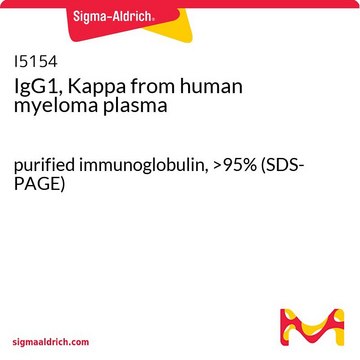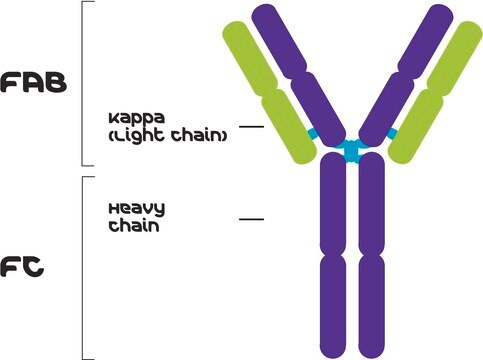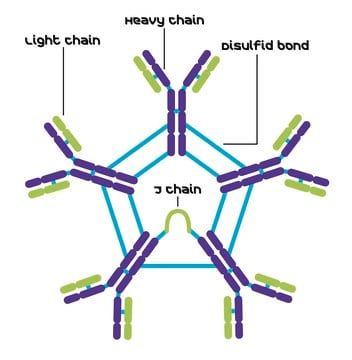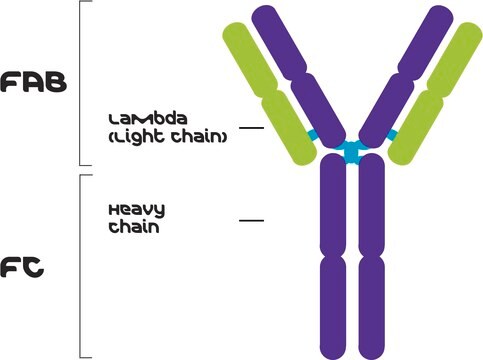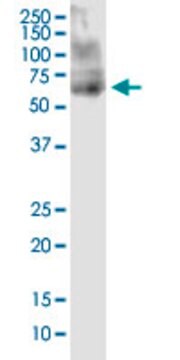M7894
IgG1, Kappa from murine myeloma
clone MOPC 21, ascites fluid, lyophilized powder
Synonym(s):
Mouse IgG1-κ
Sign Into View Organizational & Contract Pricing
All Photos(1)
About This Item
Recommended Products
biological source
mouse
Quality Level
conjugate
unconjugated
antibody form
ascites fluid
clone
MOPC 21, monoclonal
form
lyophilized powder
application(s)
research pathology
storage temp.
2-8°C
target post-translational modification
unmodified
Looking for similar products? Visit Product Comparison Guide
General description
The MOPC-21 tumor line that produces mouse IgG1, κ is a mineral oil induced plasmacytoma originated and carried intraperitoneally in BALB/c mice. Immunoglobulins G are made up of two identical light chains and two identical heavy chains, that are covalently connected by interchain disulphide bonds. Mouse IgG is further divided into five classes- IgG1, IgG2a, IgG2b, IgG2c and IgG3.
Application
IgG1, Kappa from murine myeloma has been used:
- in stimulation assay and enzyme-linked immunosorbent assay (ELISA)
- as isotype controls in islet hormone production
- in flow cytometric analysis, in cell migration assay
- as control antibody in evaluation of methylation
Biochem/physiol Actions
IgG antibody subtype is the most abundant of serum immunoglobulins of the immune system. It is secreted by B cells and is found in blood and extracellular fluids. It provides protection from infections caused by bacteria, fungi and viruses. Maternal IgG is transferred to fetus through the placenta that is vital for immune defense of the neonate against infections.
Immunoglobulin G (IgG) participates in hypersensitivity type II and type III reactions. IgG helps in opsonization, complement fixation and antibody dependent cell mediated cytotoxicity.
Reconstitution
Reconstitute with 1 mL deionized water.
Disclaimer
Unless otherwise stated in our catalog or other company documentation accompanying the product(s), our products are intended for research use only and are not to be used for any other purpose, which includes but is not limited to, unauthorized commercial uses, in vitro diagnostic uses, ex vivo or in vivo therapeutic uses or any type of consumption or application to humans or animals.
Storage Class
11 - Combustible Solids
wgk_germany
WGK 3
flash_point_f
Not applicable
flash_point_c
Not applicable
ppe
Eyeshields, Gloves, type N95 (US)
Certificates of Analysis (COA)
Search for Certificates of Analysis (COA) by entering the products Lot/Batch Number. Lot and Batch Numbers can be found on a product’s label following the words ‘Lot’ or ‘Batch’.
Already Own This Product?
Find documentation for the products that you have recently purchased in the Document Library.
IL-6 promotes malignant growth of skin SCCs by regulating a network of autocrine and paracrine cytokines
Lederle W, et al.
International Journal of Cancer. Journal International Du Cancer, 128(12), 2803-2814 (2011)
J Zhu et al.
American journal of respiratory and critical care medicine, 164(12), 2220-2228 (2001-12-26)
We wished to determine if the inflammatory cells surrounding the airway mucus-secreting glands in chronic bronchitis (CB) were associated with interleukin (IL)-4 and IL-5 mRNA expression and whether the CD8 T cell population expressed these cytokines. Digoxigenin-labeled IL-4 and IL-5
Eva Obermueller et al.
Cancer research, 64(21), 7801-7812 (2004-11-03)
Tumor growth and progression are critically controlled by alterations in the microenvironment often caused by an aberrant expression of growth factors and receptors. We demonstrated previously that tumor progression in patients and in the experimental HaCaT tumor model for skin
DNA counterstaining for methylation and hydroxymethylation immunostaining in bovine zygotes
Heras S, et al.
Analytical biochemistry, 454, 14-16 (2014)
Differentiation of embryonic stem cells conditionally expressing neurogenin 3
Treff NR, et al.
Stem Cells, 24(11), 2529-2537 (2006)
Our team of scientists has experience in all areas of research including Life Science, Material Science, Chemical Synthesis, Chromatography, Analytical and many others.
Contact Technical Service

